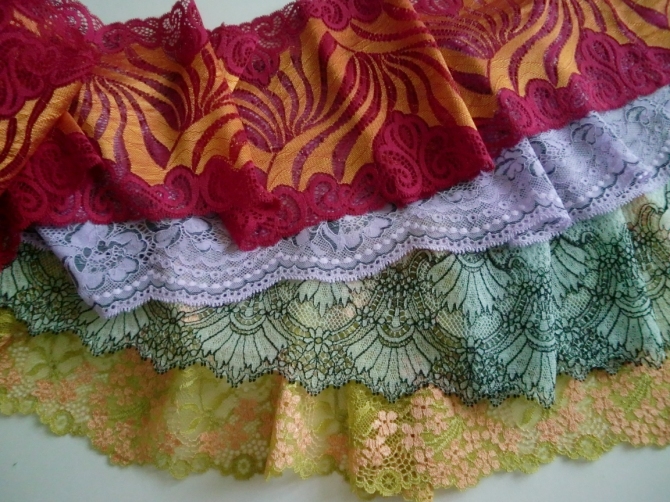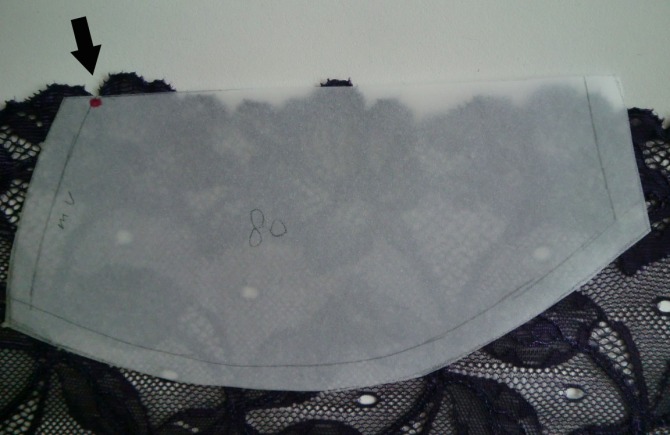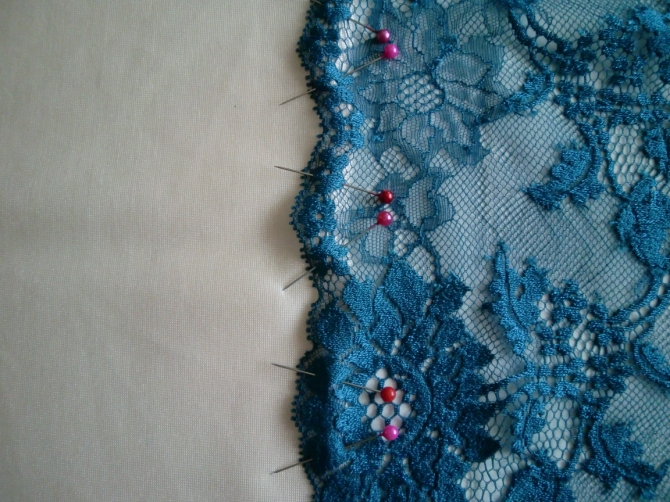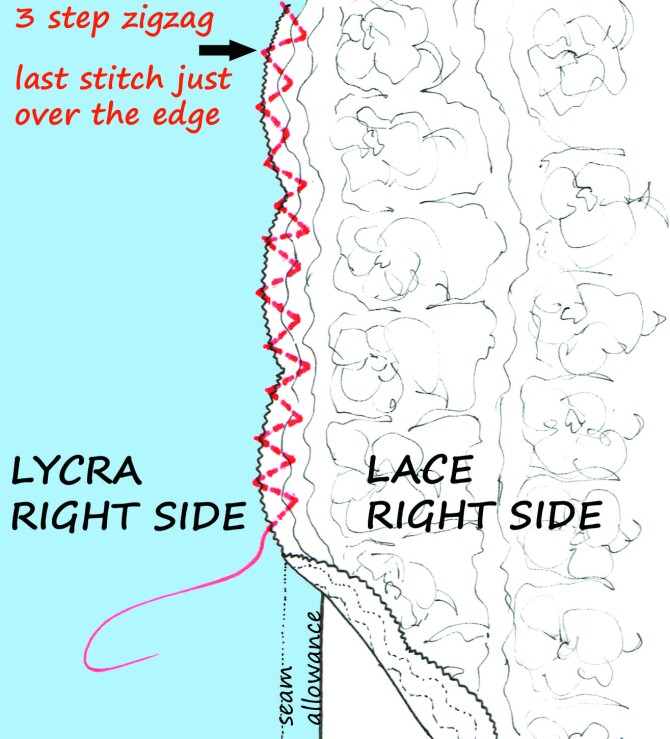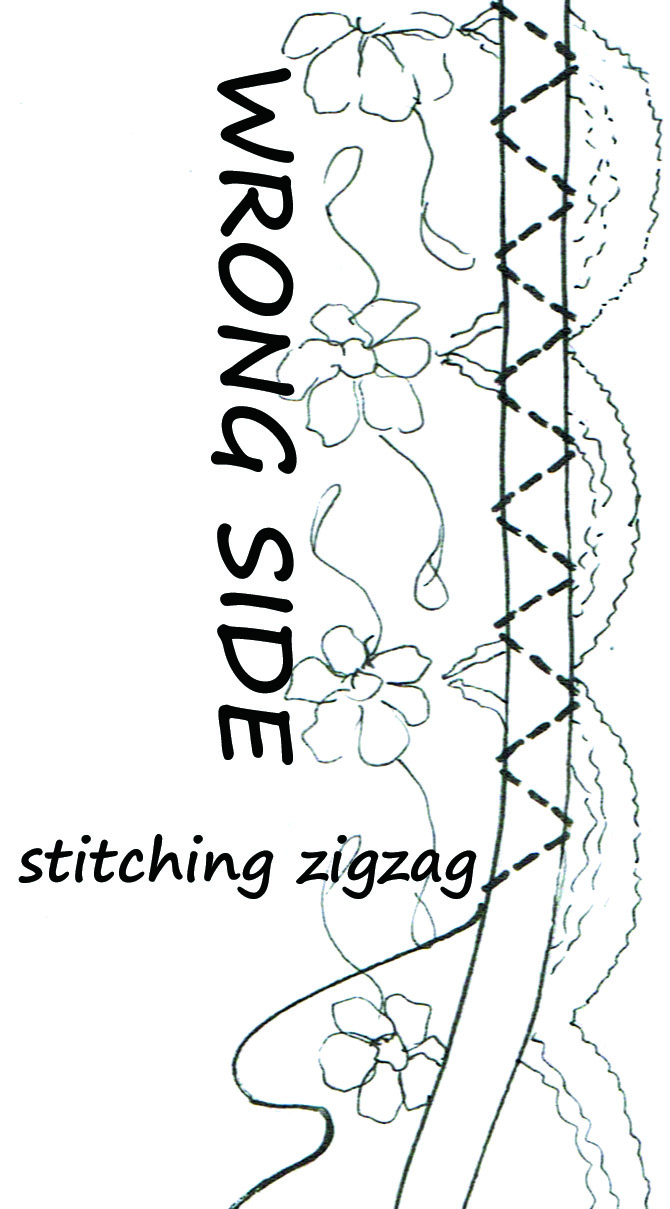Recently I’ve added a new DOWNLOAD sewing pattern in my Etsy shop for a SWIRL panty with lots of scalloped lace in it. Since using scalloped lace galloons can be a challenge sometimes, it seemed a good idea to share some tricks with you! It all starts with the pattern parts of course, you can only use the parts for scalloped lace that have a straight edge. Or at least more or less straight. That’s because a scalloped lace galloon is always straight at the scalloped edges. For any rounded edge you would have to cut away the scallops. Which you probably don’t want to do because the lace was choosen because of the lovely scalloped edges!
Without any other option you could cut a narrow strip from the scalloped edge and just sew this on the rounded raw edge. Use an overlock stitch (serger) because you don’t want to loose any stretch which is always along the scallops. But this is not an ideal option of course. A better option would be to adjust the pattern part and transform the rounded part into a straight lined part. This calls for real pattern drawing skills though, not an easy job to do and only for the ones who follwed pattern drawing classes. For anyone else I suggest you just stick to the pattern as it is available and use only the straight edges for the lace scallops.
Next issue is how to cut the scalloped part. Do the scallops stay within the pattern or do they go over the pattern edge? Well. that’s open for discussion and there are no strict rules. This will also depend on how large the scallops are, some galloons have just very small scallops while other scallops can differ several cm from lowest to highest point. But there is one important rule : where the scallops connect with another seam nothing should go beyond the pattern edge!
Let’s take a bra cup as an example. The top edge of the cup connects with the triangled bridge at midfront. When this top edge of the cup is from scalloped lace you should use this rule at the cup midfront. Make sure at that point the scallop ends exactly at the pattern edge. Nothing, really nothing, should go beyond that pattern edge! It doesn’t matter whether it is at the lowest or the highest part of the scallop (or anywhere in between) just make sure at this connecting angle it’s an exact match. For the remaining edge it doesn’t really matter, the scallops can go over and under the pattern edge as seems fitt. In the picture you will see the arrow pointing at the red dotted angle I described. Don’t get confused by the seam allowance, at the red dot is the stitching line where the pattern connects and NOT at the edge of the seam allowance! All this is the same for any other pattern part, where scallops connect with another part they should be exactly at the edge of the pattern!
Now we get to stitching the parts together. Like all stretch materials scalloped lace should be stitched with an overlock stitch to preserve the stretch of the material. However sometimes the scallops are not on the outer side of the garment, they will be stitched right on top of another piece. Using a serger would just cut off all the scallops which we don’t want. This technique is used in several of my Merckwaerdigh sewing patterns for briefs and bras. First step is pinning the fabrics; as you can see in the picture the pins are placed transverse on the scallops. This way the fabrics cannot start sliding away as they tend to do when the pins are placed along the scallop edge.
Now which stitch to use? With a straight stitch the stretch will be lost. A regular zigzag is stretchy but will tighten the stitching. For topstitching scalloped lace the best stitch will be the stitching (3 steps) zigzag. Don’t just stitch in a straight line though, the scallops will start folding while wearing the garment. Follow the roundings of the scallops but DON’T move the fabric around during stitching. This might work with woven non-stretch fabrics, but stretch fabrics will be stretched out and start to get ‘wavy’. There is no other option; you must lift the machine foot constantly, make a few stitches – lift foot and move fabric – make a few stitches – lift foot and move fabric and so on.
Another need trick is to let the stitching cover the scallop edge completely. You do not stitch within the lace but you let the outer stitch end just OUTSIDE the scallop. When done right you can’t feel the seam at all and the fabric looks like just one fabric. And isn’t lingerie just all about the feel?
Another tricky detail can be at the bra cups. What to do with the lining? When the scallops at the top edge of the cup are not exactly following the pattern the lining might get visible at some lowest parts of the scallops. In that case you will have to cut the lining in one straight line following the lowest parts of the scallops. Don’t cut along with the roundings of the scallops! The top edge of the lining can’t be left open, you will have to cover this with narrow elastic. And this can only be done when the top edge is a straight line. For this extra narrow covering elastic (I always call this cup elastic) the same stitching 3 steps zigzag wil be the best option. The stitching will cover the elastic at both sides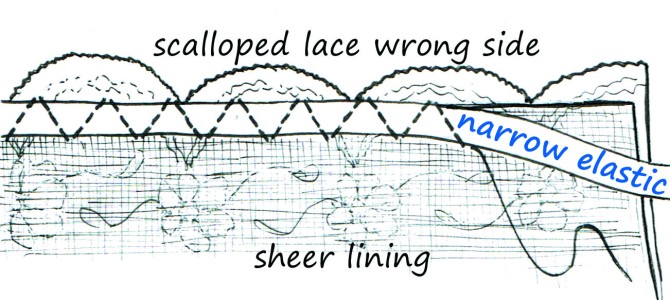
When scalloped lace is used at the outer edge (other than in the cup with lining) you can add elastic the same way; at the wrong side of the lace just under the lowest parts of the scallops. When the elastic is too wide to be covered completely it’s better to use a narrow zigzag stitch along both lengths of the elastic, again covering the edges of the elastic. When the edges are left free they might start irritating the skin after a while.
Any picots will be completely invisible so no need to use up your most precious elastics, but the color of the elastic might shine through since lace is always kind of sheer. Even a matching color can become too much deepening the color, always try the elastic behind the lace before starting to stitch. having to remove the elastic after stitching is complete horror!
For an overview of all the Merckwaerdigh internet activities and the button to suscribe to the Merckwaerdigh Newsletter take a look at www.merckwaerdigh.nl
